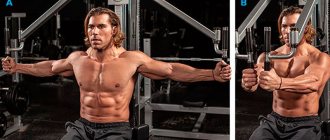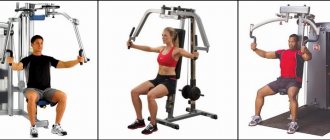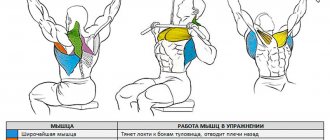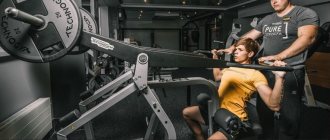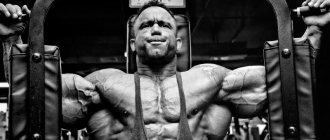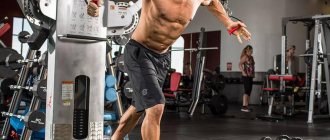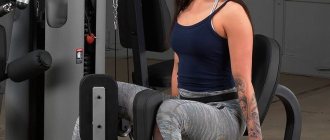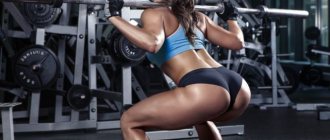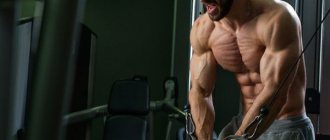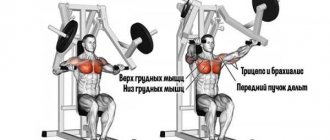To work on the pectoral muscles, various variations of compressions and presses are used. Some of them can be performed with the help of additional sports equipment. The “Butterfly” exercise machine is popular with both beginners and experienced athletes when working the chest area. Let's figure out what kind of instrument this is and how to do the exercise correctly.
What is a "butterfly"
The Butterfly trainer is a design designed for mixing. It consists of a backrest, a chair and handles, which are attached to the load using a frame. During mixing, weights increase the load on the working area. It can be varied in weight. “Butterfly” got its name due to its appearance: frames with handles diverge to the side like wings. Some models have elbow rests, which makes work even more isolated.
How to replace the exercise
If the gym does not have butterfly or peck-deck machines, you can consider the following as a replacement:
- Bent-over rear delt fly.
- Abduction of the arm upward while lying on the bench sideways.
What kind of exercise
Bringing your arms together in a “butterfly” or otherwise “peck-deck” is an isolated exercise for the pectoral muscles. They are the ones who do the work of bringing the arms to each other, contracting their fibers. The remaining muscles are practically not involved in the movement. It occurs in the shoulder joints according to the type of rotation - remember that this is a ball-and-socket joint, the head of the shoulder rotates in the glenoid cavity. The elbows and other joints of the upper limb bones remain fixed. The same applies to the body.
It is believed that mixing in the “butterfly” refers to additional exercises. It is mainly used for “clogging” muscles at the end, as well as for pumping. But for beginners, this is an excellent start in chest work.
Benefits and disadvantages of exercise
The main advantages of reverse peck-dec breeding:
- Isolating study of the lagging beam.
- Improved posture and turning your shoulders back.
- Prevention of hernias and diseases of the spine in the lumbar and cervical regions.
- Suitable even for beginners.
- Neuromuscular control is not necessary to obtain benefits as with other posterior band exercises.
The disadvantages are conditional. Basically they come down to the wrong technique for performing a reverse butterfly.
What muscles work
The pec-dec pinch is considered an isolated exercise for the pectoral muscles: major and minor. They are the main “engine”. When performed correctly, tension is felt in the chest area, along the anterior outer surface of the chest. The maximum load falls on the middle beams. Additionally, the exercise involves:
- anterior delta bundles;
- serratus anterior;
- coracobrachialis muscle;
- biceps.
These muscles belong to the girdle of the limb and the upper chest. They continue to bring their hands together. Not everyone pays attention to which muscles help support the torso and legs. The following roles play a role in stabilizing the body:
- latissimus muscles;
- diamond-shaped;
- erector of the back;
- biceps and quadriceps femoris;
- gluteal muscles.
Their participation here is minimal. They simply hold the pose on the chair.
Benefits of the Butterfly Exercise for the Chest Muscles
Despite the simplicity of the design of the simulator and the movements performed on it, the “butterfly” has several advantages in comparison with more complex, complex exercises:
- High-quality “grinding” of the relief of the pectoral muscles (the exercise does not allow you to lose the main muscle mass of the chest, the results of its implementation are reflected superficially).
- When the arms are brought together, the pectoral muscles are qualitatively stretched, blood circulation in the upper body is accelerated, which leads to the saturation of the body cells with useful substances.
- During the “butterfly” exercise, all areas of the chest are involved, including previously unworked muscle bundles.
- For girls, the exercise is of particular importance: the “butterfly” tightens the shape of the bust.
- The deep part of the midline of the chest develops, as a result of which the border between the left and right pectoral muscles becomes visible.
- Only the chest muscles are involved in the work, the other groups are isolated from movement.
Reduction of arms in the simulator
The visible relief of the pectoral muscles is the result of performing the “butterfly”
Visible relief of toned pectoral muscles as a result of performing the “butterfly”
What are the pros and cons
Mixing in the simulator is suitable for all athletes. But its advantages and disadvantages should be taken into account when including it in the program.
pros
- ease of implementation;
- isolated load on the chest;
- you can exercise during the rehabilitation period and at the beginning of chest training;
- good pumping effect;
- muscles work throughout the entire movement;
- minimum tension on the hands and shoulders;
- you can effectively finish a chest set with this exercise;
- Suitable for both men and women.
Minuses
- you need sports equipment - a butterfly simulator;
- if you are not careful about the technique, there is a risk of injury;
- it’s easy to overdo the weight – only the pectoral muscles work, unlike other exercises;
- This exercise alone cannot achieve a significant increase in volume; a “base” is required.
For beginner athletes, the exercise can be made the main element of the set for a while, and then moved to the end of the workout. This will promote muscle growth and volume without the risk of injury or damage. You should be careful about the weight you choose. You can't take too much, since only pectoral groups work. This means less weight is required.
How to do the splits in a week
To quickly do the splits, you need to pay a lot of attention to stretching every day. The most effective exercises can be found in ballet, yoga and stretching.
Butterfly and reverse butterfly
This exercise is static and helps to quickly increase the depth of the stretch. To protect yourself from pain, before you start stretching, you need to do some cardio exercises to warm up your muscles.
The butterfly is performed lying on your back. Bend your legs and bring your feet closer to your pelvis. Now spread your knees to the sides, opening your pelvic area.
Connect the soles of your feet and use your hands to help (without fanaticism) your knees move towards the floor.
The “reverse butterfly” is performed from a lying position, face down, when the legs, open in the same position as in a regular butterfly, move apart under the weight of their own weight, since the pose turns out to be inverted.
Smile and wave
Swinging your legs forward, to the side and back is the simplest exercise to improve stretching. Despite the simplicity? swinging with the maximum amplitude of which you are capable helps to quickly warm up the muscles and increase the elasticity of the tendons.
To start, do 50 swings forward, sideways and backwards. To complicate the task, when performing side swings, move your leg as far to the left as possible when swinging your right leg and to the right as possible when swinging your left leg, in a crisscross pattern to form a scissors.
Lunges with a shift in the center of gravity
Another exercise that can be performed without additional equipment is lunges with a shift in the center of gravity. We put our feet together and step forward as far as possible. Next, bend your leg at the knee and shift your body weight forward. You will immediately feel the muscles “crackling”.
The same movement can be performed to the side.
We stepped, bent our leg at the knee, and extended the second one. Now, leaning our hands on the floor, we begin to move the weight of the body from the bent leg to the center (the leg will unbend) and to the other leg (eventually it will bend at the knee, and the one from which come - he will stretch out).
Standing leg stretch
The stretch is performed while standing on one leg. Roll your left foot from heel to toe so that your weight is comfortably distributed. Bend your right leg so that your heel points toward your buttock.
Place both hands behind your back, grab the toe of your foot with your fingers and pull it as close to your butt as possible. The more intensely you do this, the more the muscles will stretch.
Do the same with the other leg.
Stretch on the floor
Sit on the floor and stretch your legs in front of you. Stretch your arms forward, placing your stomach first on your thighs and then your body. To help yourself, try reaching your toes with your hands and grabbing them with your hands. This exercise can be performed with your legs spread wide apart. Then the stretch will not be on the hamstrings, but on the inner side of the thigh.
Video lessons on stretching
Execution technique
Correctly performed mixing is the key not only to sports success, but also to health. Therefore, follow the instructions for the technique:
- position the seat so that your arms are brought together in front of your chest;
- make sure that the back and seat allow you to sit without tilting your body;
- handles - in neutral position;
- put the required weight on the machine;
- sit on the seat: keep your back straight, press your shoulder blades to the back;
- lower your legs to the floor and place them on the sides - your feet should rest on the surface;
- if the feet do not reach the floor, place pancakes or any other support;
- grab the handles of the machine with a neutral grip;
- move your shoulders back, straighten your back and remove unnecessary bends (the natural position of your back in the lumbar region is maintained);
- keep your head straight;
- take a breath;
- as you exhale, bring your arms together in front of you;
- keep your elbows slightly bent – “soft”;
- hold at a point in front of you for 1-2 seconds by contracting the pectoral muscles;
- return to the starting position;
- repeat the movement the required number of times.
To start training, you can do 10-14 repetitions of 2-3 approaches. For good pumping – 5-6 approaches of 10 times. Experienced athletes can perform 2-3 sets of 12 times with heavy weights and 2 sets of 10-12 times with lighter weights. Select weight individually: on average, it is recommended to start with 10-15 kg.
Subtleties
There are professional subtleties in performing the exercise that will improve your work:
- make the movement smoothly without jerking: reduce it to 2 counts;
- moving your arms up, the load goes to the upper part of the chest, and down – to the lower part;
- rest between sets for no more than 2 minutes;
- start the set with a warm-up;
- finish working on the chest with stretching;
- at the start of the exercise you need to feel a stretch in the chest area;
- do not move your hands away from the midline;
- keep your shoulders down;
- fix your feet without excessive zeal - no need to try to push off with your feet;
- avoid any body movements when mixing;
- tighten your abdominal muscles;
- eliminate “movements” of the coccyx;
- It is better to use less weight, but more attention to detail and technique;
- direct your gaze straight ahead.
The essence of all reduction options is the work of the pectoral muscles to bring the arms in front of you closer to the midline. All of these nuances help to “focus” the body on an isolated load. Particular attention should be paid to monitoring the maintenance of correct posture.
Execution option
Some models of the simulator have supports for the forearms and elbow joints. You need to place your elbow on soft pads and turn your arm at an angle of 90 degrees to your shoulder. In this position, the movement should be performed in a similar pattern. The main “bonus” of this additional option is even more isolated work on the pectoral muscles.
Preparing for the exercise
This movement completes the set of exercises for the chest muscles. It is understood that joint exercises and pre-stretching are done before the first bench press. Beginners should perform no more than 12 working approaches of all exercises per workout; experienced athletes can do more by individually selecting the load.
Stretching muscles in the middle of a workout before one exercise makes no sense. Typically, such actions reduce the strength of muscle contractions and reduce the effectiveness of the exercise.
The exception is stretching the triceps after the main pressing movements. You need to sit on a bench, place your forearm behind your head and lightly press on your elbow. This will help you bring your arms in front of you more comfortably, but will not remove the tone from your chest.
Common mistakes
The following mistakes often happen when mixing:
- arms are too straight - fully extended at the elbow joints;
- head down;
- rounding in the back, deflections;
- jerking movements;
- assistance with feet by inertia;
- lifting the feet off the floor;
- separation of the shoulder blades from the back;
- placing your hands behind the midline;
- too much weight;
- working too hard;
- the simulator is not adjusted to individual parameters (most often it is not adjusted according to height);
- gripping the handles very tightly, with a lot of tension in the hands;
- no coordination with breathing.
Another “mistake” can be considered high hopes for rapid muscle growth only on mixing. But this will not happen if you do not use other chest exercises.
Recommendations for bringing your hands together in the butterfly simulator
When performing the movement, you do not need to place your arms too far behind your back. Also, you should not straighten your arms completely (this applies to the model of the simulator designed for movement with outstretched arms). Failure to observe these points may result in injury. Increase the working weight gradually. In this exercise, it is important to stretch the muscles as much as possible rather than loading them with heavy weight. Thanks to good insulation, a lot of weight is not needed. This exercise is important to perform after complex basic exercises.
- Girls should perform 15-25 repetitions of 3 sets;
- for men – 12-14 repetitions of 3-4 sets.
Contraindications
Sometimes working in a “butterfly” is not recommended, despite all its safety. Restrictions include:
- stretching or tearing of working muscles;
- intercostal neuralgia;
- myositis;
- arthritis in the acute stage;
- fever;
- recent spinal injuries;
- severe scoliosis and other deformities of the spinal column;
- periarthritis of the shoulder and elbow joints.
It can be difficult to tell muscle, joint and ligament problems apart. But the common “signal” is pain and difficulty moving. Then it is better to go to the doctor rather than to the gym.
Skeleton of a normal pitch deck
Universal structure:
- Start right away with the problem or introduce yourself (short bio) - if your professional authority can help the matter.
- Outline the problem, prove that it is a real problem.
- Give a concrete and elegant solution.
- Show a possible market or target audience.
- Introduce the product/service itself.
- Sketch a business plan.
- Describe the financial capabilities of the startup.
- Introduce competitors and similar solutions.
- Show your investment goals.
The order of points varies widely. If you have something to show, you can stretch one point over two slides, etc. In general, the structure of the pitch deck is reluctant to be formalized; each team tries to distinguish itself and be remembered at least at the level of the sequence of slides.
Is there an alternative
Sometimes the question arises of what to replace “pek-dek”. If there is no “butterfly” in the gym, but you want to work on your chest in the same way, then there is an alternative:
- bringing your hands together with dumbbells on a bench: straight or inclined;
- crossover mixing in the upper block;
- bringing together in front of you in loops.
These exercises do not repeat the work in the “butterfly” and cannot be a complete analogue. But the essence of the movement is the same. Alternatively you can use.
Bringing your arms together in a “butterfly” makes it easier to work on the pectoral muscles and helps to form a beautiful relief. The exercise is performed using a special simulator. You need to customize it for yourself. This reduction is suitable for all categories of athletes, but is an isolated and additional element of the program. During movement, you need to control your body and body position for better effect and safety. There are restrictions on loads. See you in the new blog! Subscribe to updates and invite friends!
Types of Butterfly simulators
There are two main types of Butterfly simulators. Each of them pumps up the pectoral muscles well, but there are certain nuances in working with them.
Let's look at them in more detail:
- Peck deck with elbow rest
The point of this design of the simulator is to exclude the forearms from the work as much as possible, so that the movement is performed exclusively by the chest muscles.
But practice has shown that such a starting position is not suitable for everyone.
Due to the anatomical features of a person, for example, different arm lengths and the inability to adjust the supports to suit oneself, part of the load falls on the anterior delta.
To correct this situation, exercise machines with palm rests were developed.
- Peck Deck with palm rest
Here the movement is more reminiscent of the classic lying dumbbell fly.
The palms rest on the handles and the movement occurs along a large arc-shaped path. As a result, the involvement of the pectoral muscles is maximum.
True, the forearm muscles work here an order of magnitude more than in the version with elbow rests.
Typically, most gyms only have one variation of the Butterfly machine. If your gym has a Peck Deck with elbow rests, but it fits you less, use one secret to reduce the load on the front deltoid.
To do this, use a hand position that is not provided for in the original instructions for the simulator.
Only rest your palms on the handles. In this case, the elbows are raised high and are in line with the hands and shoulders.
As a result, the movement is close to that which is done in the simulator for palm resting. The only difference is that in the Pek Deke with support for the elbows, a shorter range of motion is obtained.
Errors during execution and recommendations for improving technique
The butterfly is often used in chest training programs by various gym goers.
The movement is quite easy, but even here there are a number of common mistakes that are more typical for beginners.
Among them:
- Excessively heavy weight
When trying to work with unbearable weights, movement technique is greatly impaired. Additional muscles come into play to help.
The butterfly is an isolating exercise that is designed to specifically target only the pectoral muscles!
Moderate weight is used so that correct movement technique can be maintained throughout the entire approach.
- The pace is too fast
With sharp and fast movements, the exercise is performed mostly due to inertia rather than pectoral strength. As a result, the load on the muscles is minimal.
The appropriate tempo of movement for bringing the hands together in the Butterfly is 1-1-2 . Which means one second to bring your arms in front of you, a second pause in the contracted position and two seconds to smoothly return to the starting position.
To involve your pecs as much as possible, in the starting position, squeeze your shoulder blades together and bring your chest forward, slightly arching your lower back.
Maintain this position throughout the movement so that the load on your pecs does not decrease.
Useful tips
When performing an athletic exercise, you should pay attention to the nuances and details. This will allow you to focus on the target muscle group and avoid common mistakes.
When performing the “Butterfly” exercise, the following recommendations are useful:
- Bringing your arms together in a machine is an auxiliary movement. It should be performed after basic barbell presses.
- Raising your arms takes 1.5-2 times longer than bringing your arms together.
- Jerks and inertia while performing the exercise are not allowed. Movements should be smooth and controlled.
- Raising your shoulders when bringing your arms together should be avoided. This violation of technique shifts the emphasis of the load to the trapezius muscles of the back.
The butterfly curl is an effective exercise for developing chest muscles. It can fit into any basic training program and is an isolated movement.
This determines the number of repetitions performed in each approach. This value should be within 12-15 repetitions. The number of approaches should not exceed 5.
Why train the pectoral muscles?
Training the chest muscles is determined not only by the goal of increasing their volume, but also by a number of factors related to maintaining human health:
| Correct posture | To give the correct position to the spine, many novice athletes try to do more exercises on the muscles of the back and shoulders. However, the pectoral muscles are their antagonist muscles. Without developed and elastic chest muscles, it is impossible to form a healthy posture. |
| Normalization of respiratory function | The development of chest muscles in combination with breathing exercises and diaphragm training can normalize a person’s respiratory function. This effect is due to the elimination of stoop and an increase in the length of the fibers of the pectoralis major and pectoralis minor muscles, as well as other small auxiliary muscle groups. This helps make the diaphragm work easier. |
| Improved functionality | The pectoral muscles are one of the strongest and largest muscle groups in the human body. Consequently, they are directly or indirectly involved in most everyday tasks. |
| Breast shape improvement | This is especially true for girls. Training the pectoral muscles will not increase the volume of the mammary glands. However, developed muscles are capable of giving an aesthetic shape and lifting the breasts. |
| Strengthening the muscles of the shoulder girdle and back | When performing sports exercises on the chest muscles, a large number of stabilizer muscles and auxiliary muscle groups are involved in the work. This makes it possible to develop the muscles of the upper shoulder girdle harmoniously. |
